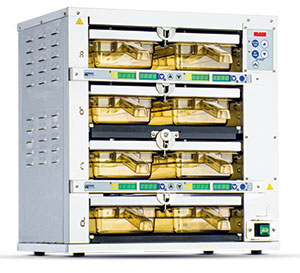A Q&A with Kyle Kestner, business unit manager, Prince Castle
 Q: Food holding sometimes has a negative connotation. But isn’t it really an important part of every foodservice operation?
Q: Food holding sometimes has a negative connotation. But isn’t it really an important part of every foodservice operation?
Kyle Kestner: Important, yes. Food holding gets a negative connotation because people think back to what holding used to be: old heat lamps that would hold finished products, like completed sandwiches, altering the taste of the food. Today’s technology is far more advanced. Today, you can hold proteins like beef or chicken, and they’ll have the exact same quality as when they came off the grill or out of the fryer.
Q: How can food holding benefit the operator in terms of product turnaround?
KK: It’s really all about speed of service. In the past, food was cooked to order. A customer would come in and order a burger. The operator would cook the burger; it would take two to three minutes. Then the sandwich would have to be built, taking an additional five minutes before the customer is out the door with the sandwich. With today’s holding bin, you get the benefit of offloading the cooking process to a low-volume time. So, you can essentially cook all your proteins before your lunch rush. Then, throughout the lunch rush, you’re essentially just building the sandwich, cutting out two to three minutes from the entire process. You get more throughput, which is more revenue for the owner/operator.
Q: How else does holding food properly save operators money?
KK: By holding correctly and holding longer, the operator reduces waste. In most cases, short hold times and not accurately anticipating demand results in waste. When an operation does not forecast its day correctly, too much food is cooked; hence, the need to throw away product, affecting an operation’s bottom line.
Q: How does food holding help with speed of service, and why is that important?
KK: For QSRs and c-stores, speed of service is imperative. Getting a customer in and out quickly means getting more tickets throughout the day. Operators are looking for anywhere that they can save time. Offloading the cooking to a low-volume time and holding during the high-volume times of day helps with that speed of service.
 The DHB and EHB holding bins allow operators to hold food longer safely without sacrificing taste.
The DHB and EHB holding bins allow operators to hold food longer safely without sacrificing taste.
Q: How do the new Prince Castle EHB and DHB holding bins use technology to help operators hold food longer?
KK: With our new EHB and DHB holding bins, we added additional heaters. This allows us to tailor the recipe to a specific food product, which will give better quality and longer hold times. In addition to adding more heaters, we switched to aluminum lids, which are more durable. The aluminum is better at conducting heat through to the food, which helps keep it hotter longer. Our bins can double an operator’s holding time.
And the EHB has connectivity, with an ethernet port on the back. It enables you to connect with kitchen management systems. It looks at POS data historically and tells you what you should be cooking and what you should be holding in your holding bin. It also allows operators to remotely push out new recipes to their holding bins over a web portal.
Learn more at www.princecastle.com



